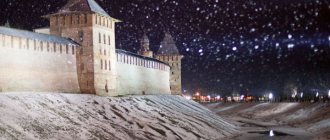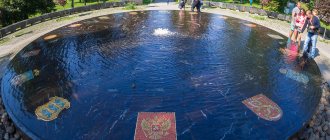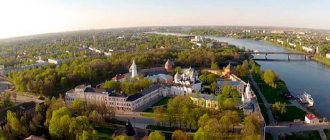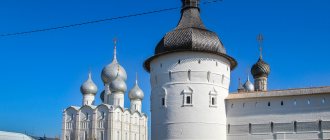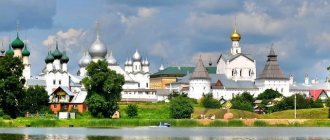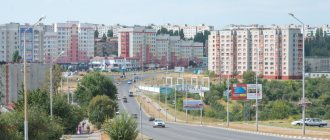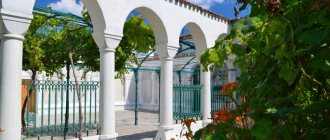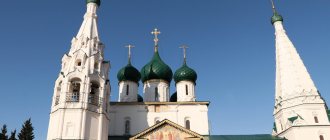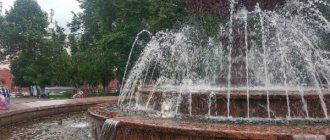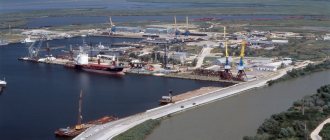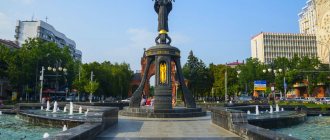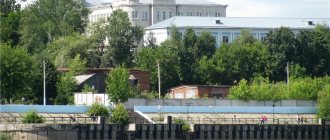Feel the multifaceted soul of Russia. Feel the unbreakable connection with the great and glorious history of your country. Touch the living and breathing antiquity of centuries. Only in Veliky Novgorod will the whole range of these touching and valuable experiences for every citizen of our country be revealed. Only by visiting the ancient Novgorod land, the birthplace of Russia, can you get to know your country.
Only here you can touch living history, more ancient than Russia itself. You will be able to see with your own eyes “where the Russian land came from” - its Orthodoxy, literacy, democracy, statehood. You will go back in time ten centuries and enjoy the famous Novgorod hospitality known since ancient times.
Veliky Novgorod history.
Since ancient times, the international Baltic-Volga trade route came through the Ilmen region, which contributed to the formation at the source of the Volkhov of a center of political interaction between the local Finno-Ugric tribes and those who came here in the 6th-8th centuries. Slavs In 862, the Scandinavian prince Rurik and his retinue were invited by the tribal leaders to perform judicial and law enforcement functions. This was the beginning of a dynasty that ruled all Russian lands for more than seven and a half centuries.
At the beginning of the 10th century, the campaigns of Prince Igor and his governor Oleg from Novgorod to the south made it possible to build a trade route “from the Varangians to the Greeks,” which accelerated the unification of the Eastern Slavs into a single state known as Kievan Rus. Victories of Alexander Nevsky's squads in 1240 and 1242. over the Swedes and the Teutonic Order, they protected Rus', weakened by the Mongol-Tatar invasion, from Catholic aggression.
What to see and where to go in Veliky Novgorod - day 2
On the second day of your trip around Veliky Novgorod, you should visit the city’s popular natural attractions and architectural monuments. You should start with the Kremlin Beach, Alexander Nevsky Embankment, Hanseatic Fountain, Kremlin Bridge, Znamensky Cathedral of Veliky Novgorod, Dukhov Monastery. After this, you can visit the Novgorod State Museum-Reserve, the V. I. Povetkin Center for Musical Antiquities, the Museum of Fine Arts, the Novgorod Regional Philharmonic, the Museum of Artistic Culture of the Novgorod Land, the Academic Drama Theater named after. F.M. Dostoevsky.
Kremlin beach
Kremlin beach
The main beach of the city is located on the banks of the Volkhov River under the walls of the Novgorod Kremlin. The place is clean and tidy, which attracts both citizens and tourists. The beach infrastructure consists of a toilet, changing cabins, sports and children's playgrounds.
The beach is in a very beautiful place. It is ideal for summer photo shoots. Here you can spend your holiday peacefully, enjoying the cool water and sunshine.
Alexander Nevsky Embankment
Alexander Nevsky Embankment
The Alexander Nevsky embankment stretches along the Trade Side of Novgorod, from the Kremlin Bridge to the Church of Boris and Gleb in Plotniki. Walking along the embankment, you can admire the view of the Kremlin and the natural landscape. Here you can go to a restaurant and try local cuisine, as well as look at the sculptures that decorate the promenade.
The embankment is perfect for a walk with family or friends. It is better to visit it in the evening. At this time you can enjoy a beautiful sunset, natural scenery and fresh air.
In the very center near the embankment there are the best housing options, based on price and reviews:
- Guest house "Lyubava on the embankment". Rating: 9.2 based on 246 reviews. Price 850 rub.
- Popular Design Hotel "Truvor". Rating: 9.3 based on 1,633 reviews. Price 1350 rub.
- Apartments "River Etudes". Rating: 10.0 based on 53 reviews. Price 1250 rub.
- Hotel "Hansa" 3*. Rating: 8.6 based on 9,868 reviews. Price 1450 rub.
Novgorod State Museum-Reserve
Novgorod State Museum-Reserve
The Novgorod State Museum-Reserve is a complex of monuments of the historical and architectural heritage of the city. The main building of the complex houses most of the exhibits related to the history of the city. In addition, here you can see a collection of ancient icon paintings.
The exhibits of this museum are in no way inferior to the exhibits of the best museums in Moscow and St. Petersburg. In addition, here you will find souvenir shops. You can buy gifts for your family, friends and colleagues there.
Hanseatic fountain
Hanseatic fountain
This fountain was built in 2009 in honor of the Hanseatic Forum in Veliky Novgorod. There are 16 coats of arms on it, which are made in mosaics. There is a legend that if you throw a coin into the fountain, your wealth will increase.
This attraction is worth a visit on the way to other places in Novgorod. The fountain has a very interesting design that attracts a lot of attention to it. It is located in a very picturesque place, so you can take beautiful photographs as a souvenir.
Povetkin Center for Musical Antiquities
Povetkin Center for Musical Antiquities
The V. I. Povetkin Center for Musical Antiquities studies and reconstructs ancient musical instruments. Here you will be introduced to the history of the Center, the subject of research in musical archaeology. In addition, you will learn how the inhabitants of Rus' understood music.
If you come to the Center on a weekend, you will be able to listen to many ancient instruments live. This is a very interesting and unusual place. You will be able to carefully examine the exhibits and understand what kind of music accompanied the lives of people several centuries ago.
Kremlin Bridge (Gorbaty)
Kremlin Bridge (Gorbaty)
The Kremlin Bridge, located near the Novgorod Kremlin, connects the Trade and Sofia sides of the city. The bridge was first mentioned in chronicles in the 12th century. However, in 1944 it was blown up by retreating German troops. The modern bridge was built in 1987.
It is best to visit the bridge on the way to another attraction. You can walk along it, enjoying the beauty of the city landscape. From here you get beautiful photographs that will remind you of your trip to Veliky Novgorod.
Znamensky Cathedral of Veliky Novgorod
Znamensky Cathedral of Veliky Novgorod
The Znamensky Cathedral of Veliky Novgorod is an architectural monument of the 17th century. Its history contains many traditions and legends. The cathedral is a building with richly decorated facades, a two-tier circular gallery and four pillars.
The architecture of the cathedral is very interesting and unusual. It attracts many tourists who are interested in architectural monuments. Here you can take atmospheric pictures that can decorate your social networks.
Spirits Monastery
Spirits Monastery
The Spiritual Monastery was first mentioned in chronicles in 1162. Throughout its existence, the temple had to endure many trials: they tried to plunder it and set it on fire many times. During the Great Patriotic War, the Nazi headquarters was located in the monastery. Today it is used as an archive, and the church does not technically belong to the diocese.
This place is worth visiting on the way to other architectural monuments. The likelihood that you will be able to see the interior of the monastery is very low, since it is closed most of the time. However, it is still worth including it in your route around the city.
You can take a walk through the colorful area and immerse yourself in the world of medieval Novgorod on this excursion:
Art Museum
Art Museum
The Museum of Fine Arts is located in the former Palace of the Noble Assembly. The exhibits of this museum will introduce you to the fine arts of Russia of the 17th-20th centuries. Most of the collection was collected in the period 1920-1930, when the Bolsheviks plundered noble estates.
Here you can find works by Shishkin, Serov, Levitan, Kuindzhi. Here you can take a close look at various works of art. The museum has a very pleasant and unusual atmosphere. The exhibits make you feel like you are being transported back in time.
Novgorod Regional Philharmonic
Novgorod Regional Philharmonic
The Novgorod Regional Philharmonic was opened in the 1940s. Today it is located in a building located next to the western gate of the Novgorod Detinets. The Philharmonic has an Orchestra of Russian Folk Instruments, a Chamber Orchestra and two ensembles, whose performances take place both at home and in foreign countries.
If you have the opportunity, be sure to attend some concert at the Philharmonic. Here you can enjoy wonderful classical music. Such a pastime will definitely leave pleasant impressions in your memory.
Museum of Artistic Culture of the Novgorod Land
Museum of Artistic Culture of the Novgorod Land
The Museum of Artistic Culture of the Novgorod Land, located in one of the buildings of the Desyatinny Monastery, was opened in 2002. Here you can see works by artists of the 20th and early 21st centuries. In addition, the exhibition includes porcelain and glass items made by local craftsmen.
At the museum you can attend master classes and thematic classes. This place will be very interesting for art lovers. You will be able to carefully examine each exhibit, studying its details.
Academic Drama Theater of Dostoevsky
Academic Drama Theater of Dostoevsky
Academic Drama Theater named after. F.M. Dostoevsky was built in 1987. Yu.S. Somova, the architect of the project, decided to combine modern influences and classical traditions in the building. The theater was based on the forms of ancient churches and towers, but columns, arches and vaults were added to it.
This place is worth visiting if only for the architecture of the building. You can also go to one of the performances that are staged in the theater. After this, you will definitely have pleasant impressions from visiting this city attraction.
Veliky Novgorod in the XIII-XV centuries.
XIII-XV centuries - this is the heyday of Novgorod. By the standards of that time, it was a large city with a population of 25-30 thousand, comparable to Lubeck, Vienna and Prague. After the entry of Novgorod land into the Moscow state, foreign guest houses were closed. Only at the beginning of the 16th century did the Hanseatic office begin to operate again, and then other trade missions appeared. Novgorod, which escaped devastation during the Mongol-Tatar invasion, preserved the greatest spiritual and artistic values that were in demand by Russian culture during the period of its new rise in the 14th-15th centuries.
Veliky Novgorod in 1 day
It’s better to start exploring the city from the Sofia side, the historical district of Novgorod. Take a walk around Detinets, admire the majestic St. Sophia Cathedral, and be sure to look into the Vladyka Chamber.
There is a wonderful park near the walls of the Kremlin. Its main attractions are the sculptural compositions. It’s also more convenient to examine the Detinets towers from the outside.
You can cross the humpbacked bridge to the Trade Side of Novgorod and continue exploring the city there. The Yaroslavovo settlement, Torg and Gostiny Dvor will not leave you indifferent.
To save time and effort, you can choose a boat trip. Then you will be able to cover more remarkable places. The motor ship leaves in the direction of the Rurik settlement and follows to Lake Ilmen.
Veliky Novgorod in modern times.
In modern times, Novgorod successfully combines old and new. After World War II, the historical part was built up so that medieval churches would not end up in the “wells” of multi-story blocks. Today Novgorod, located on the Moscow-St. Petersburg highway, has good economic and cultural ties with both capitals, Karelia, the Baltic states, and attracts foreign investors. Novgorod is one of the Russian cities that are part of the New Hanseatic League.
Sights of Veliky Novgorod
Veliky Novgorod will be an excellent holiday destination for people who love and are interested in the history of Russia. Here every tourist can find an interesting attraction. In Novgorod you will feel the atmosphere of history and antiquity. Here you can stroll through picturesque streets, architectural complexes, museums, and theaters. The city's restaurants and cafes are worth visiting to enjoy local cuisine. Veliky Novgorod will definitely be able to leave a pleasant and unforgettable impression.
In this article we have prepared for you a list of city attractions that may interest you. Thanks to him, you will think through your route around Novgorod in advance. This way you will definitely not end up in boring and uninteresting places.
- Novgorod Kremlin, Kremlin Park, St. Sophia Cathedral of Veliky Novgorod
- Sophia Square, Monument “Millennium of Russia”, Church of the Transfiguration on Ilyin Street
- Chamber of Facets, Anthony's Monastery, Rurik's settlement
- St. Nicholas Cathedral, Clock ringing, Gate tower of Veliky Novgorod
- White (Alekseevskaya) Tower, Desyatinny Monastery, Yaroslav's Dvorishche and Ancient Marketplace
- Kremlin Beach, Academic Drama Theater named after. F.M. Dostoevsky, Nikolo-Vyazhishchi Monastery
- Alexander Nevsky Embankment, Novgorod State Museum-Reserve
- Hanseatic Fountain, V. I. Povetkin Center for Musical Antiquities, Kremlin Bridge (Gorbaty)
- Znamensky Cathedral of Veliky Novgorod, Spiritual Monastery, Museum of Fine Arts
- Novgorod Regional Philharmonic, Museum of Artistic Culture of the Novgorod Land
- St. George's Monastery, Vitoslavlitsy Nature Reserve, Church of the Assumption on Volotovo Field
- Holy Trinity Michael-Klopsky Monastery, Church of the Annunciation in Arkazhi, Perynsky Skete
- Museum of Bells, Lake Ilmen, Spaso-Preobrazhensky Varlaamo-Khutyn Convent
At the end of the article we have placed a map of Veliky Novgorod with the sights marked on it that we mentioned in the article. Using this map, it will be easier for you to navigate the area, and also, if you wish, you can develop your own travel route to the sights.
Attractions. Novgorod Kremlin - Detinets.
Novgorod Detinets (also Novgorod Kremlin) is a monument of Russian military-defensive architecture of the 15th-17th centuries, located on the left bank of the Volkhov River. The first chronicle mention of it dates back to 1044. It is an architectural monument of federal significance and is protected by the state. The Novgorod Detinets, as part of the historical center of Veliky Novgorod, is included in the UNESCO World Heritage List. Since its foundation it has been the political, religious and cultural center of the Novgorod land. Here is the oldest temple in Russia - St. Sophia Cathedral, the monument "Millennium of Russia", the oldest civil building preserved on the territory of Russia - the Vladychnaya (Faceted) Chamber. Of the 12 towers that existed in Detinets in the 15th century, nine have survived: Dvortsovaya, Spasskaya, Knyazhaya, Kokuy, Pokrovskaya, Zlatoustovskaya, Metropolitan, Fedorovskaya and Vladimirskaya.
Unknown Veliky Novgorod or What to see in a city where, it seems, you’ve already seen everything
I’ve been to Veliky Novgorod God knows how many times: I walked along the banks of the Volkhov, admiring the sunrises and sunsets, explored numerous surrounding monasteries - abandoned and not so abandoned, admired the waking up children from the height of a hot air balloon, and even once took part in the festival “Nord” Race”, when it was still held at the local airfield (but this is completely a legend of deep antiquity, mesozoic, so to speak, no less)... In general, we have been friends with Novgorod for a long time and closely. And then one warm May day I felt the need to once again find myself on its ancient streets.
Necessary means necessary. And since I’m also a fan of combining business with pleasure, on the eve of leaving I began to be tormented by thoughts - what kind of thing could I see there at the same time? Well, it’s really an interesting question: what to do in Novgorod if, it seems, you’ve already seen everything there? By this time, I had already been collecting dust for five years on sketches of a route through the ancient Novgorod temples, on the one hand, located away from traditional tourist paths, on the other, being honorary figures on the list of UNESCO World Heritage Sites, and this already means something. As Winnie the Pooh would say: “This is LJJ for a reason!” In general, it would be strange if in a city that was one of the first in Rus' to accept the Christian faith, these churches could be counted on the fingers of one hand. Here, as usual: in each yard there is an ancient church of the 12th century. At the same time, most of them are inactive: some house branches of the Novgorod Museum-Reserve, others house offices and production, and there is even one that until recently housed an ordinary apartment building... In general, there is something to see!
It takes fifteen minutes to put together a program for the day, and early in the morning I’m already hurrying along the M10 “Russia” federal highway to the region where the formation of the Russian state once took place.
The road from Tsarskoye Selo to Novgorod today takes less than two hours; the condition of the asphalt has been more than decent for several years now. True, cameras with radars have recently begun to grow along its entire length, like mushrooms after rain. But this, nevertheless, is more good than bad - the accident rate on Russian highways is still off the charts, and something definitely needs to be done about it.
Having left home at the beginning of eight in the morning, by nine I was already in Novgorod. Recently, they have been creating heavy-duty jackets for real travelers. Meet Igor Frolov. In 2015, while everyone was whining about sanctions, the difficulties of import substitution and other adversities, he moved here from St. Petersburg and established the production of practical and high-quality outerwear.
The Holy of Holies is a set of patterns necessary for cutting fabrics and insulation.
Nordwestfur uses the best materials and fittings that can be found on the market. This is a story about quality, when the confidence that the chosen clothes will not let you down in the harshest conditions is above all. And everything else fades into the background.
Jackets are made from several types of fabrics: some are rough and practically indestructible - designed for expeditionary conditions, others - softer - for daily use.
The insulation is exclusively synthetic, withstanding frosts down to minus fifty degrees. Down is not suitable for our climate - in conditions of high humidity it gets wet and crumples, losing most of its properties, and, if something happens, drying a wet down jacket in expeditionary conditions is an almost impossible task.
Igor considers his employees to be the main asset of his company. The basis of production is a technologist and four seamstresses. They produce up to 100 jackets a month, which, like hot cakes, immediately fly all over Russia.
The jackets are really, really cool. I will definitely use them on my expeditions.
The production is located in the former treasury building, right on the territory of the ancient Spiritual Monastery. This monastery is mentioned in the chronicles of the 12th century. With the advent of Soviet power, the monastery was closed; today its premises house the State Archives of the Novgorod Region, as well as several offices and production workshops.
Very close by, literally a couple of hundred meters from the monastery, stands probably the most beautiful of the unlined churches of Veliky Novgorod - Peter and Paul in Kozhevniki (built in the early 15th century). In the old days, leather workers lived here, and since their activities are not accompanied by the smell of roses (when I remember the tanneries that are still operating in Fez, I shudder), their workshops were moved outside the city.
Nowadays, this church is the only building from the times of the Novgorod Republic, which has been almost completely restored to its original appearance - this is exactly what this temple looked like immediately after construction was completed.
In the center of Novgorod, on the territory of the former Plotnitsky End, there is a street with the romantic name Fedorovsky Ruchey. On it stands the Church of Fyodor Stratilates on the Stream (built in the second half of the 14th century).
Fedorovsky Brook, called Plotnitsky before the church was built, was filled up in the 1950s. You can see what the church looked like some seventy years ago in archival footage (source: ; author: Grigory Shtender).
Exterior.
Interior.
In the corner, as if nothing had happened, stands an ancient sarcophagus from the 14th century. The church was built with the private funds of one of the Novgorod mayors, so a family tomb was built at its southern facade.
Only fragments of the painting have been preserved inside. In the 19th century in Novgorod, there was a fashion for painting over ancient frescoes. At the beginning of the 20th century, someone finally realized that the paintings of local churches were of the highest cultural value, and in the early 1900s, work was carried out in many churches to restore the paintings.
The decor of the Church of Fyodor Stratelates on Ruchyu is significantly different from other Novgorod churches: it is made in red-brown tones, which betrays its Byzantine origin. It is believed that these frescoes were created either by Theophanes the Greek himself or by one of his students.
Novgorod is a city of ghosts. Here’s how it turns out: the Fedorovsky Stream, on which the temple stands, seems to be there, but it’s not there. And the church itself seems to be standing, but it’s not there either - there is a museum inside. And the frescoes decorating its vaults seem to be widely known, but almost nothing remains of them either - only minor remnants of torn ocher spots on the whitish walls.
On church vaults you can find inscriptions scratched in the 14th-15th centuries, the so-called “graffiti”: “Don’t make noise, walk quietly”, “And they are singing on the platform at the Holy Intercession”, “Sava came with me from the bargaining, beat me, I wrote."
On the banks of the Volkhov there is the Rossiya Hotel, where I had the imprudence to stay once, about five years ago. Across the road from it there is a picturesque ensemble of two churches - Michael the Archangel on Torg and Annunciation on Torg, created in the 14th century and rebuilt several times until the end of the 19th century. Today, according to the ancient Novgorod tradition, there is a souvenir shop, a travel agency and an accounting company located here.
A little to the side, next to the old moat that once surrounded Novgorod from the east, there is another architectural ensemble - the churches of Peter and Paul on Slavna and Elijah the Prophet on Slavna. In the old days, one of the entrances to the city was located here.
The Church of Peter and Paul was built in the second half of the 14th century. True, in later times the temple was rebuilt - in the 15th and 16th centuries. The Church of Elijah the Prophet was built at the beginning of the 15th century on the site of an older stone temple of the 12th century, which was taken as the basis.
Both churches were heavily damaged during World War II. This is how they looked in the late 1940s (source: ; author: Lyubov Shulyak).
The Church of Peter and Paul was more fortunate: it began to be restored immediately after the end of the war. Today it is included in the list of UNESCO World Heritage Sites.
The Church of Elijah the Prophet did not have time to restore, and in the early 1950s its dome collapsed. Instead of being included in the list of UNESCO World Heritage Sites, it was destined to become an apartment building.
The building existed in this capacity to this day, until a couple of years ago when all the residents were evicted.
Nowadays, the church has been handed over to the Old Believers. Access here is limited.
Let's take a short break and head out of town.
There, in the vicinity of Veliky Novgorod, there are several more ancient churches. The most interesting and, at the same time, the most difficult to reach of them is St. Nicholas on the island of Lipno (or, in short, St. Nicholas on Lipno). It is located in the floodplain of the Msta River and can be reached either in winter - on foot on ice, or in summer - by boat. The Church of St. Nicholas on Lipna is closed to visitors, and a visit to it must be agreed in advance with the Novgorod Museum-Reserve, under whose jurisdiction it is located.
A visit to this temple was to be the main point of my program. Everything started well: permission to visit the church was received, a caretaker was waiting for me on the island, and local fishermen promised to take me there on their boat, and, it seems, even back.
And then (suddenly!) on the way to Novgorod, I was informed that from the end of April to the beginning of June the use of motors in the Msta floodplain is prohibited - an all-Russian spawning ban is in effect. This is where my previously coherent plan traditionally begins to fall apart at the seams.
I really want to get to the island, and legally, and I’m starting to figure out on the fly how I can do this. First of all, I’m going to the outskirts of Novgorod to the local GIMS, in case they give me permission to visit the island. There they greet me surprisingly hospitably, and are happy to help, but issuing such permits is beyond their competence: it is not the GIMS that sets spawning bans; it is not the GIMS that monitors their implementation, but I need to go to the Federal Fisheries Agency. Luckily for me, the heads of all departments are well acquainted with each other, so a short call and they are already waiting for me at the Department of State Control, Supervision and Fishery Protection for the Novgorod Region, on a street with the fabulous name Dobrynya. There they welcome me like family: they not only give me permission to visit the Msta floodplain, but also provide me with an escort with a boat that will take me to Lipno Island and back.
Our path lies upstream of the Volkhov all the way to Lake Ilmen, where we need to find one of the branches of the Msta River.
A couple of kilometers from Novgorod, there is the ancient Rurik settlement, where in ancient times the residence of the Novgorod princes was located. Now a museum complex is being created there, which should open next year.
Lake Ilmen covers an area of about 700 square kilometers. In spring, when the snow begins to melt, its area increases approximately 3 times.
Previously, I didn’t really understand what the spring flood on Ilmen was like, but, preparing to visit Lipno Island, I found two photographs on the Internet (source: ; author: Alexander Kochevnik) - and, to be honest, I was a little crazy.
Left: Lipno island in spring, when the snow melts. Right: the same place in autumn, with low water. And now the main thing: such metamorphoses happen here every year!
I'm lucky. Without even suspecting it, I found myself at the Church of St. Nicholas on Lipna at the most interesting and exciting time of the year - in the spring, when the temple stands on a small island, surrounded on all sides by the flooded Ilmen.
The Church of St. Nicholas on Lipne was built at the end of the 13th century. At that time, there was already a monastery on this site, founded around the 1110s and existing until the middle of the 18th century. After it was abolished, the buildings were gradually dismantled and only one church of St. Nicholas remained of the monastery, practically abandoned and over time falling into disrepair. Surprisingly, until the Second World War, frescoes created during its construction were preserved on its walls. This is what the temple looked like at the beginning of the 20th century (source: ; author: unknown).
And so - in 1946. The bell tower was demolished at the dawn of the Soviet era, and during the Second World War, an observation post of Soviet troops was located on the island, so it was periodically mercilessly hit by a German artillery battery located on the western bank of the Volkhov, just six kilometers from Lipno (source: ; author : unknown).
Surprisingly, before the war ended, the restoration of Novgorod churches began. And by 1956, the Church of St. Nicholas on Lipna was returned to its original appearance.
In general, for researchers of Russian architecture this is one of the most favorite objects. Studying works devoted to this temple, I was able to find several dozen scientific publications, the earliest of which date back to the middle of the 19th century.
The Church of St. Nicholas on Lipna became the first stone structure in Novgorod built after the Mongol-Tatar invasion. In addition, Western European architectural borrowings begin to be found here for the first time in Novgorod, testifying to the close ties of that time between Novgorod and the cities of Western Europe.
The date of construction of the church is considered to be 1292. This date is recorded in all Novgorod chronicles of that time.
The painting of the church was carried out immediately after its construction.
It is believed that this is the only monument in Russia with preserved frescoes from the 13th century.
The work carried out by restorers in the middle of the 20th century was colossal. The temple was literally recreated piece by piece. The church walls still preserve the history of that time.
In the fall of 2016, Putin and Medvedev visited the church. Immediately after their visit, a loud announcement was made: the church would be renovated. True, after just a few months, this idea got lost somewhere in the labyrinths of the bureaucracy, so whether or not to be the restoration promised by the president is a big question.
Maybe it’s for the better: we know how monuments are restored in our country: it’s good if they just cover it with scaffolding and start sucking up money from the budget for all sorts of “foundation studies,” otherwise they might disfigure everything. It's better to stand as is.
We are greeted by caretaker Margarita Stepanovna, who has been living on the island for the past two years. Two huge shepherd dogs help her guard the monument from uninvited guests.
The caretaker's house was built in 1984. Living conditions here are quite harsh: there is no electricity or running water.
Margarita Stepanovna does not like to be photographed.
- Why is this? - asks. - For memory! - I answer. - Here's another! — he says, “What do you want to look at in the photograph?” And so: if you get bored, come and visit!
She has a treasure trove of stories. In the fall, journalists came and asked to tell us something about the church. Well, she answered them that she wouldn’t tell anything, they say, she’s not a historian, she’ll blurt out something wrong now, and they’ll write about it in the newspaper, there will be a scandal, let them look for information themselves, isn’t that what the Internet is for? - and went into the house. The journalists were apparently offended and wrote in one of the local newspapers that the church stood on a deserted uninhabited island. The next day, her friend calls the caretaker: Have you moved off your island?
Margarita Stepanovna shows us her property: “But here there used to be a bathhouse.” Shortly before Putin’s arrival, the FSO arrived and forced it to be dismantled: helicopters would fly in and all the slate from the roof would fly away. God forbid, the president or prime minister will get hooked.
Now there is no bathhouse on the island.
— The helicopters actually arrived, as many as six of them. And here are Siberian cedars, they were brought specially from Tomsk in 1979 and planted here. That's how they grow.
It's time for us to return to the mainland. We say goodbye to the hospitable caretaker, thank her for preserving all this beauty for us, and promise, if necessary, to return.
Lipno Island is left behind. An abandoned building on the shore is a sports base built for skiers in anticipation of the 1980 Olympics.
And we are entering Volkhov. On the left hand are the white towers of the Yuryev Monastery, one of the oldest in Russia.
Our further path lies on the lands located between the winding riverbeds of the Volkhov and Msta. You can get there by car.
The Church of the Transfiguration of the Savior on Kovalev (built in the mid-14th century) is the only surviving building of the Spaso-Kovalyov Monastery that once existed on this site.
The temple was almost completely destroyed during the Second World War. For three years he was on the front line, and during this time he turned into a pile of rubble.
Along the perimeter of the restored church there is a deep, broken groove, similar to an old, lingering scar. It shows the level of what remained of the temple at the end of the war.
Another pearl from the times of the Novgorod Republic is the Church of the Savior on Mount Nereditsa.
The temple was built at the end of the 12th century. This is what it looked like in 1880 (source: ; author: unknown).
In 1903-1904 the temple was repaired, returning it to its original appearance. These works became the first truly scientific restoration of a cultural object in Russia.
Soon after the start of the Great Patriotic War, the church found itself in the very center of the defensive line stretching from Lipno to Kovalevo, and by the autumn of 1941 only ruins remained of it (source: ; author: unknown).
The restorers managed to do the impossible - to restore the church practically from the dust.
Fragments of the frescoes, once one of the most famous monuments of monumental painting on a global scale, were taken to the Novgorod Museum, where they have been restored for many decades and are gradually returning to their rightful place.
Here, as in the Church of Fyodor Stratilates on the Stream, ancient “graffiti” has been preserved - inscriptions scratched by parishioners and ministers directly on the walls of the temple.
In addition to the inscriptions, there are also various images, for example: a fairy-tale monster, horsemen and a warrior with weapons.
A multimedia center is modestly hidden behind one of the columns, allowing you to get acquainted with various interesting facts. High technologies are coming.
And we are going to the Rurik settlement.
The road is flooded by the overflowing Volkhov. You can only cross over a narrow bridge.
The bravest ones wade.
Rurik's settlement is an ancient trade, craft and military-administrative center of the Ilmen region, located at the source of the Volkhov.
Previously, this place was simply called Gorodishche. The specification “Rurikovo” appeared only at the beginning of the 19th century under the influence of legends that identified this area with the first capital of Ancient Rus'. Novgorod historians and archaeologists foam at the mouth to prove that it was here that Russian statehood was born (the mention of Staraya Ladoga, where Rurik originally came, and where, most likely, he reigned for the first couple of years, until he moved to the shores of Ilmen, can easily lead them to before a heart attack).
Be that as it may, the Rurik settlement was indeed the site of a princely residence in the 9th century, and this place undoubtedly played an important role in the formation of the Russian state.
From the Rurik settlement there is a beautiful view of the walls of the Novgorod Detinets.
The Sadko ship flits back and forth along the Volkhov, taking tourists to Lake Ilmen and back. I once walked on it about five years ago.
Novgorod is one of the cities included in the New Hansa. This is a pseudo-historical formation designed to develop trade and cultural ties between cities that were once part of the Hanseatic League.
Why I adore this city is because here World Heritage sites are found literally at every step. Here, for example, is the Church of the Twelve Apostles on Propastekh, built in the mid-15th century, and, as if nothing had happened, standing surrounded by Soviet Khrushchev buildings.
Next to it is an old earthen rampart that surrounded the city in the 16th century. Its length is about six kilometers. Nowadays, this is a favorite place for Novgorod residents to walk their dogs.
At sunset we went to the Perynsky monastery. It is located a few kilometers from Veliky Novgorod on the left bank of the Volkhov, just south of the Yuryev Monastery.
Once upon a time, on this site there was a sanctuary of Perun, the Slavic pagan thunder god, built here by order of Prince Vladimir. He, nine years later, ordered this idol to be thrown into the Volkhov, and the inhabitants of Novgorod to be baptized, which was done.
More than ten centuries have passed since then, and this place is called Peryn to this day.
It is believed that the first church on the site of the former pagan sanctuary appeared already in 995, but no information about it has been preserved. It is likely that a monastery was founded here around the same time, although the first mention of it in the chronicles is found only in 1386 - in the list of monasteries burned by the Novgorodians when the army of the Moscow prince Dmitry Donskoy approached.
The monastery in its modern form appeared in the 19th century, although the Church of the Nativity of the Virgin Mary, located on its territory, has stood on this site at least since the middle of the 13th century. By the way, this is one of the smallest and probably the most elegant temples in the Novgorod land.
BBQ party? In fact, these are just seedlings of young trees, carefully covered by the monks with old barbecues they found on the banks of the Volkhov.
While visiting the Peryn monastery, a strange story happened to me.
I don’t believe in mysticism, and I have a rather peculiar relationship with religion, but only after passing through the gates of the monastery, it was as if I had entered another world. There, behind the fence, a strong wind was blowing, the trees were rustling and birds were screaming, but here it was as if I was under an invisible protective dome - the sounds were muffled, there was no wind. It seemed that a couple of moments ago I had crossed some invisible border separating two worlds.
And most importantly: as soon as I entered the territory of the monastery, a feeling of some incredible peace descended on me. What in religion is usually called the word “grace”.
Twenty minutes later I returned back to the world. As soon as I was outside the gate, a gust of cold wind flew in from somewhere and hit me in the face. Birds screamed in the sky. The furious Volkhov made noise with all its waves. And somewhere in the distance, on the opposite bank, the Church of the Savior on Nereditsa blushed in the rays of the setting sun.
The evening was spent in a warm, friendly company with my Novgorod balloonist friends (who wanted to fly in a hot air balloon? -). I returned home only at the end of the night. The morning dawn was breaking over St. Petersburg.
Don't switch!
I sincerely thank everyone without whom this trip would not have taken place: - chief curator of the Novgorod Museum-Reserve Yulia Nikolaevna Kolomtseva; — Head of the Department of State Control, Supervision and Fishery Protection for the Novgorod Region Igor Aleksandrovich Viktorov; - employees of the GIMS of the Ministry of Emergency Situations of Russia in the Novgorod region.
Saint Sophia Cathedral.
Novgorod St. Sophia Cathedral is one of the most outstanding monuments of ancient Russian architecture. This is the oldest surviving ancient Russian temple in Russia. Built by Prince Vladimir, the son of Yaroslav the Wise, in 1045 - 1050, the St. Sophia Cathedral ceased to be a princely temple already in the 30s of the 12th century, turning into the main temple of the Novgorod Republic. Until today, Novgorod Sophia is a symbol of the city, and the words spoken by Mstislav the Great in the distant 12th century: “Where St. Sophia is, there is Novgorod” still excite the hearts of the townspeople.
Monasteries of Veliky Novgorod
The main religious places of the city are ancient monasteries with historical temples and churches. This is the most important part of the cultural heritage of Veliky Novgorod.
Yuriev Monastery
A monastery located on the outskirts of the city near the banks of the Volkhov River. Founded in 1030 and is a UNESCO protected site. The initiator of the creation of the monastery was Grand Duke Yaroslav the Wise. The monastery includes three cathedrals - St. George, Holy Cross and Spassky, the Church of the Archangel Michael and the Burning Bush Icon of the Mother of God, a four-tiered bell tower 52 meters high.
Khutyn Monastery
Located 7 km from the city on the outskirts of the village of Khutyn. Founded in 1190 by the monk Varlaam, who, according to legend, expelled evil spirits from these places. The most famous building of the monastery was the Church of Gregory of Armenia, now only ruins remain of it. Within the walls of the Transfiguration Cathedral is the grave of the poet Derzhavin. Currently, the monastery is being actively restored after destruction during Soviet rule.
Nikolo-Vyazhishchi Monastery
Founded in 1411 and has a high stauropegial status - reporting directly to the patriarch. The monastery had a high status back in the 17th century - it was patronized by the kings of the Romanov dynasty. To date, several ancient centuries-old buildings have been preserved - St. Nicholas Cathedral, the Church of the Evangelist John the Theologian and the Church of St. Apostle, decorated with colored tiles on the outer sides of the buildings.
Klopsky Holy Trinity Monastery
A men's monastery located 20 km from Veliky Novgorod at the confluence of the Veryazhi and Ilmen. Founded in 1408. The central building of the monastery is the Trinity Cathedral, built in the 1560s and preserved to this day. From 1934 to 2005, the monastery did not function; during the Great Patriotic War, its buildings were badly damaged. Currently, restoration work is underway at the monastery.
Perynsky monastery
The founding date is considered to be 995. Presumably the monastery was founded on the site of a pagan temple. The monastery was first mentioned in documents in 1386 as one of the monasteries burned by the Novgorodians before the arrival of Dmitry Donskoy’s troops. Now the monastery belongs to the St. George's Monastery. On its territory there is one of the architectural monuments of the 13th century - the Church of the Nativity of the Virgin Mary, measuring only 7.5 * 9 * 12 meters.
Anthony's Monastery
The monastery was founded in 1106 and abolished in 1920. The Cathedral of the Nativity of the Virgin Mary, built at the beginning of the 12th century, shortly after the founding of the monastery, has survived to this day among the monastery buildings. Since 1125, frescoes have been preserved on the walls of the cathedral, which in the 20th century were discovered under the paintings of the 19th century; they were cleaned and restored. The premises of the monastery now house the faculties of the University named after Yaroslav the Wise.
Zverin-Pokrovsky Monastery
It is located near the confluence of the Gzen River and the Volkhov River. The exact date of construction has not been established; it was first mentioned in documents in 1148 as being burned by a lightning strike. The monastery flourished in the 19th century. The main monastery church of the Intercession of the Virgin Mary has been known since the 12th century. The Church of Simon the God-Receiver with frescoes from the 15th century has been preserved since 1467. The Intercession Cathedral has been in operation since 1899.
Derevyanitsky Monastery
It was first mentioned in chronicles in 1335. The main Resurrection Cathedral was built in 1700. It has an unusual design - all the complex vaults of the cathedral are supported by just two pillars. Its facades are decorated with figured stone. In 1725, the Church of the Assumption of the Virgin Mary with a five-tier bell tower was erected. The figured completion of the bell tower adds expressiveness to the entire monastery ensemble.
Desyatinny Monastery
The now abolished monastery, which was first mentioned in the Novgorod chronicles in 1327. The ruins of the Church of the Nativity of the Virgin Mary, built in 1327, several buildings and a bell tower, built in 1809 and rebuilt in 1903, have survived to this day from the entire monastery ensemble. One of the surviving and restored nursing buildings now houses the Museum of Artistic Culture of Veliky Novgorod.
Millennium Monument.
The ideological basis of the monument is the affirmation of the principles of “autocracy, Orthodoxy and nationality.” The monument is a large round pedestal covered with high relief figures, on which is mounted a huge ball depicting a “power” with a cross rising at the top. The pedestal depicts 109 high relief figures of various figures of political history, science, art and literature, ranging from the Kyiv princes of the 10th – 11th centuries to outstanding representatives of Russian culture of the mid-19th century.
Church of the Intercession of the Blessed Virgin Mary.
The Church of the Intercession of the Blessed Virgin Mary is located in the western part of the Kremlin, closely adjacent to the eastern facade of the Kremlin wall and the Intercession Tower. The first chronicle mention dates back to 1305, when the mayor Semyon Klimovich erected a stone church at the gate from Prusskaya Street (that is, the church was above the gate, attached to a wooden tower). In 1389, by order of mayor Grigory Yakunovich, the old church was dismantled and a new temple was erected in its place.
The Sovereign or Faceted Chamber.
The Vladychnaya or Faceted Chamber of the Novgorod Kremlin is one of the most interesting buildings of the once large complex of structures of the medieval Vladychny court. Construction work was carried out by order of Archbishop Euthymius in the 30s of the 15th century, as evidenced by references in ancient chronicles. The image of the chamber and foreign master builders was preserved in a chronicle miniature of the 16th century. Initially, the Vladyka's Chamber, built of brick, was surrounded by an open gallery, typical of Gothic buildings, it was illuminated by high lancet windows, and portals with a bowed pediment led into the interior. The paintings were completed in 1441. Unfortunately, in the following centuries, the building, both outside and inside, underwent significant changes.
Ensemble of Yaroslav's Court.
If the architectural center of the Sofia side of Novgorod has always been and remains to this day Detinets, then on the Trade Side this kind of role to a certain extent belonged to the architectural ensemble of the Yaroslav's Court. A small territory, known for a long time in the Novgorod chronicles under the name of the Prince, or Yaroslav's court. The courtyard is located on the right bank of the Volkhov opposite the southern half of the Detinets. Judging by the name, the emergence of this court dates back to the middle of the 11th century. In the Novgorod chronicles, the Yaroslav's court under the name of the "Prince's Court" is mentioned for the first time in 1113 in connection with the construction of the princely church of St. Nicholas here. The name “Yaroslav’s Court” first appears in the chronicles in 1208.
Vitoslavlitsy
“Vitoslavlitsy” is a museum of folk wooden architecture. The name comes from the village of Vitoslavlitsy, which existed here in the 12th-18th centuries. The rather vast territory of the museum contains wooden houses and churches that miraculously survived and were brought here from all over the area.
You can go into most of the houses - the life of bygone times has been restored there. Unfortunately, I didn’t think to take a tripod with me from the car, so I didn’t get any interior photos.
Tiered Church of St. Nicholas from the village of Vysoky Ostrov, 1757.
View from the opposite side. In the background is the Church of the Nativity of the Virgin from the village of Peredki, 1539.
Kletskaya Trinity Church from the Rökon Hermitage, 1676.
An old hut.
18th century chapel, from the village of Kashira.
Near one of the huts, a very colorful grandmother was sweeping water from the flooring with a broom.
Church of the Assumption from the village of Kuritsko, 1595. Behind her you can see the frozen surface of Volkhov.
If you walk a little further, a beautiful view will open up. The real Mother Rus'... To the left of the birch tree, if you look closely, you can discern the ruins of the Rurik settlement.
Rurikovo Settlement is a trade, craft and military-administrative center of the Ilmen region, which reached its maximum development in the 9th century. The settlement is located south of Veliky Novgorod, at the source of the Volkhov River from Lake Ilmen. In ancient times, here was the residence of the Novgorod princes, with which many names of famous political figures of Ancient Rus' are associated. To this day, all that remains of the settlement are the ruins of the old church, destroyed during the Second World War.
Yuriev Monastery. View from Vitoslavlice.
Church of Peter and Paul in Kozhevniki.
The church is located outside Zemlyanoy Town in an area called Kozhevniki, where furriers once lived. Since their work was associated with extremely unpleasant odors, tanners lived outside the city limits. Built in 1406, the stone temple is one of the most beautiful in the city. Initially, the monument looked the same as it does now.
Veliky Novgorod, only here you can touch living history, more ancient than Russia itself. You will be able to see with your own eyes “where the Russian land came from” - its Orthodoxy, literacy, democracy, statehood. You will go back in time ten centuries and enjoy the famous Novgorod hospitality known since ancient times.
What to see in Veliky Novgorod - day 1
You should start the first day of your trip around Veliky Novgorod by visiting the architectural monuments of the city. For example, you can see architectural monuments. We recommend visiting the St. Sophia Cathedral of Veliky Novgorod, the Church of the Transfiguration on Ilyin Street, the Anthony Monastery, the St. Nicholas Cathedral, and the Tithe Monastery.
After this, you should head to the Novgorod Kremlin, the Kremlin Park, the Faceted Chamber, the Rurik Settlement, the Clock Bell, the Gate Tower of Veliky Novgorod, the White (Alekseevskaya) Tower, the Yaroslav's Courtyard and the Ancient Marketplace, to Sophia Square, and also look at the monument “Millennium of Russia” .
Novgorod Kremlin
Novgorod Kremlin
The Novgorod Kremlin was founded in the 11th century on the banks of the Volkhov River. Its dimensions are larger than those of the Moscow Kremlin. On its territory there are towers that were erected in different centuries. Of the 12 towers, only 9 have survived today, and the most interesting are Spasskaya, Zlatoustovskaya, Dvortsovaya, Pokrovskaya.
The territory of the Kremlin is striking in its scale. Here you can walk for a long time, looking at the architecture, towers and enjoying the natural beauties. It is better to come to the Kremlin in warm weather, then your excursion will be comfortable.
Kremlin Park
Kremlin Park
Around the Novgorod Kremlin there is a beautiful park, which occupies an area of 25 hectares. Construction of the park began in the 19th century. In the Soviet Union, sports grounds were located in the park, but during the war it was badly damaged. When the war ended, the Novgorod landmark was restored.
This place is perfect for a calm and peaceful holiday. In the park you can enjoy the beauty of the city’s nature and take a break from the noisy streets. In the park you can find a tennis court, boat rentals, cafes and attractions.
In the very center of Veliky Novgorod there are the best housing options, based on price and reviews:
- Mini-hotel “On Prusskaya, 8”. Rating: 9.0 based on 474 reviews. Price 950 rub.
- Hotel History 3*. Rating: 9.3 based on 429 reviews. Price 1150 rub.
- Popular Hotel Sofia. Rating: 9.3 based on 1,353 reviews. Price 1550 rub.
- Hotel Volkhov 4*. Rating: 8.6 based on 2,468 reviews. Price 1650 rub.
St. Sophia Cathedral
St. Sophia Cathedral
The cathedral was built in the 11th century, but its early structure, made of wood, burned down in a fire. The new temple was built of stone, and Kyiv craftsmen took part in its construction. During the Great Patriotic War, the temple was looted. When the war ended, all the relics were returned to the cathedral.
The cathedral attracts the attention of tourists with its beauty and grandeur. Inside the temple you can see ancient frescoes and icons. It is worth coming here because of the relics of saints that are kept in the cathedral.
Sofia Square
Sofia Square
Sofia Square is the main square of the city. It has two names: in the 19th century it was called Sophia Square, and after the war it was renamed Victory Square. Concerts, fairs, and festive events take place on the square. Because of this, it is one of the most favorite places of citizens and tourists.
From here you can visit the Museum of Fine Arts and the Government Building. The area of the square is decorated with ancient lanterns, which give it a special charm. It's nice to stroll here in the evenings, enjoying the beauty of the city at night.
Monument "Millennium of Russia"
Monument "Millennium of Russia"
The Millennium of Russia monument was built in 1862. It is made of granite and bronze. The top of the sculpture has the shape of a power, and the main part of the monument consists of images of great Russian figures. For example, here you will see Prince Vladimir, Dmitry Donskoy, Peter I.
This place is worth visiting on the way to another attraction of Novgorod. The monument is located in a picturesque part of the city. It amazes tourists with its grandeur and beauty.
Local residents will tell you about the city in as much detail as possible on these excursions:
- Veliky Novgorod: immersion in antiquity. Rating: 5.0 based on 61 reviews. Price 3950 rub. (for 1-5 people)
- The drunken history of Veliky Novgorod. Rating: 5.0 based on 15 reviews. Price 5000 rub. (for 1-6 people)
- Secrets of the Nerevsky end in Veliky Novgorod. Rating: 5.0 based on 38 reviews. Price 3000 rub. (for 1-10 people)
- Acquaintance with the architecture of Ancient Rus'. Rating: 5.0 based on 53 reviews. Price 3550 rub. (for 1-5 people)
Church of the Transfiguration on Ilyin Street
Church of the Transfiguration on Ilyin Street
The Church of the Transfiguration on Ilyin Street was built in 1374. This temple has preserved the frescoes of the Byzantine master, which makes it a truly unique architectural monument. The frescoes of Theophanes the Greek have been preserved only in several parts of the church: in the dome and the Trinity chapel.
This place is worth including in your itinerary around the city. The murals of the temple are unique and unforgettable. You should definitely see with your own eyes the unique frescoes located inside the church.
Faceted Chamber
Faceted Chamber
The Faceted Chamber, built in 1433, is one of the oldest surviving civil buildings in Rus'. Russian and German craftsmen took part in the construction. Today, exhibitions of jewelry and ancient Russian applied art are held here.
The building of the Chamber of Facets itself looks very atmospheric. Here you can walk around the large hall, looking at the exhibits of the exhibition. This place is worth including in your route, as well as taking a few photos that will remind you of your visit.
Anthony's Monastery
Anthony's Monastery
Anthony's Monastery was built in 1117-1119, and a few years later it was painted with beautiful frescoes. During the Novgorod pogrom, the temple suffered severe damage, but it was restored in the 18th century. Today the Anthony Monastery is part of the museum-reserve.
The monastery is located in a very beautiful place. The colorful nature perfectly complements the appearance of the majestic temple. The monastery is worth a visit to see its interesting architecture, as well as the frescoes with which it is decorated inside.
Rurik settlement
Rurik settlement
The Rurik settlement is a unique archaeological site, which is located at the source of the Volkhov River. It is believed that Rurik arrived here, called to reign. This territory has long begun to attract archaeologists, and the first excavations took place in 1901.
Today this place has become interesting not only for archaeologists, but also for tourists. The most remarkable part of the settlement are the picturesque ruins of the Church of the Annunciation. Here you can take colorful photos against the backdrop of an interesting landmark.
St. Nicholas Cathedral
St. Nicholas Cathedral
St. Nicholas Dvorishchensky Cathedral was originally used as the prince's house church. During Soviet rule, the cathedral housed a combination of worship and excursions, and during the war the Germans used it as a barracks. When the war ended, the temple was returned to the parishioners.
Today, the St. Nicholas Cathedral is part of the Novgorod Museum-Reserve. Anyone can visit it. The territory of the cathedral is quite large, which will allow you to walk around and carefully examine the architectural monuments.
Clock ringing
Clock ringing
The clock ringing is part of the Novgorod Kremlin. Previously, it served as the bell tower of the Church of St. Sergius of Radonezh. Information about the construction date of the building and its author remains unknown. During the war, the clock bell was severely damaged, but was restored in the 1970s. Thanks to this, the landmark regained its former appearance.
If you decide to visit the Novgorod Kremlin, do not neglect this attraction. Arriving here, you will be able to examine an interesting architectural detail: the clock ring is slightly deviated from the straight axis to the north-west, which can be seen from the side. This place complements the colorful landscape of the ensemble, which is worth capturing in photographs.
You can immerse yourself in the atmosphere of Novgorod as it was in the post-war decades, before the revolution and in the distant Middle Ages on this excursion:
Gate tower of Veliky Novgorod
Gate tower of Veliky Novgorod
The Gate Tower of Veliky Novgorod, located on the territory of the Yaroslav Palace, was built in 1686. During the existence of this building, it housed a magistrate, an orphanage, a city school and an archive. Today there is a museum here, the exhibition of which is dedicated to ancient Christian cast plastic.
In the museum you can see crosses, amulets, church items and products of the Old Believers. You can come here with children. The gate tower is located in a very picturesque place, which will allow you to take a walk after visiting the museum and admire the beauty of the architecture.
White (Alekseevskaya) Tower
White (Alekseevskaya) Tower
The White (Alekseevskaya) Tower is the only surviving building from the defensive complex of the 16-17th century. The tower was built at the end of the 16th century and was named after the Alekseevskaya Church. In 2022, the building was reconstructed and opened to visitors.
This place can be visited on the way to other attractions of Veliky Novgorod. Inside the tower there is an exhibition of ancient weapons. Here you can learn the history of the tower, which served as a defensive complex.
Desyatinny Monastery
Desyatinny Monastery
The Desyatinny Monastery was founded in honor of the salvation and liberation of Novgorod from the Suzdal people. Its name means that the temple was built on the prince's tithe. Many buildings have not survived to this day, and the monastery is not active.
The architecture of the complex has incredible beauty and grandeur that you need to see with your own eyes. Here you can organize an original photo session. Such photographs will preserve pleasant impressions of visiting this attraction.
Yaroslav's Dvorishche and Ancient Market
Yaroslav's Dvorishche and Ancient Market
Yaroslav's Dvorishche and Ancient Marketplace are a historical complex of buildings. Here are located architectural monuments that were built between the 12th and 18th centuries. The basis of the courtyard is the temples. The Cathedral of St. Nicholas the Wonderworker, the Temple of Paraskeva Pyatnitsa, and the Church of St. George at Torg have survived to this day.
This place is perfect for people who want to experience the ancient culture of Novgorod. Here you can take a leisurely stroll, enjoying the good weather and beautiful buildings. In addition, you will take many vivid photographs that remind you of this trip.
You can understand the significance of Veliky Novgorod in the commercial, religious and cultural history of Russia on this excursion:
